Rights and Independence in Health and Social Care: Anne's Case
VerifiedAdded on 2020/01/07
|13
|3730
|158
Report
AI Summary
This report delves into the multifaceted aspects of user rights within the health and social care domain, employing Anne's case study to illustrate key concepts. It meticulously examines the influence of current legislation, including the Care Act 2014, Equality Act 2010, and Human Rights Act 1998, on organizational policies designed to promote user rights and independence. The analysis extends to factors affecting the promotion of rights, such as staffing, communication, and the individual's level of dependence. The report further investigates the impact of communication among care workers and individuals, emphasizing its role in fostering empowerment. Additionally, it explores factors contributing to loss of independence and social exclusion, alongside an evaluation of organizational systems and processes aimed at enhancing user participation. Finally, the report addresses the tensions that arise when balancing individual rights with the care provider's duty of protection, and reviews legislation and policies related to medication management, culminating in an assessment of their effectiveness within a health and social care setting. This comprehensive approach offers valuable insights into the complexities of providing holistic and rights-based care.
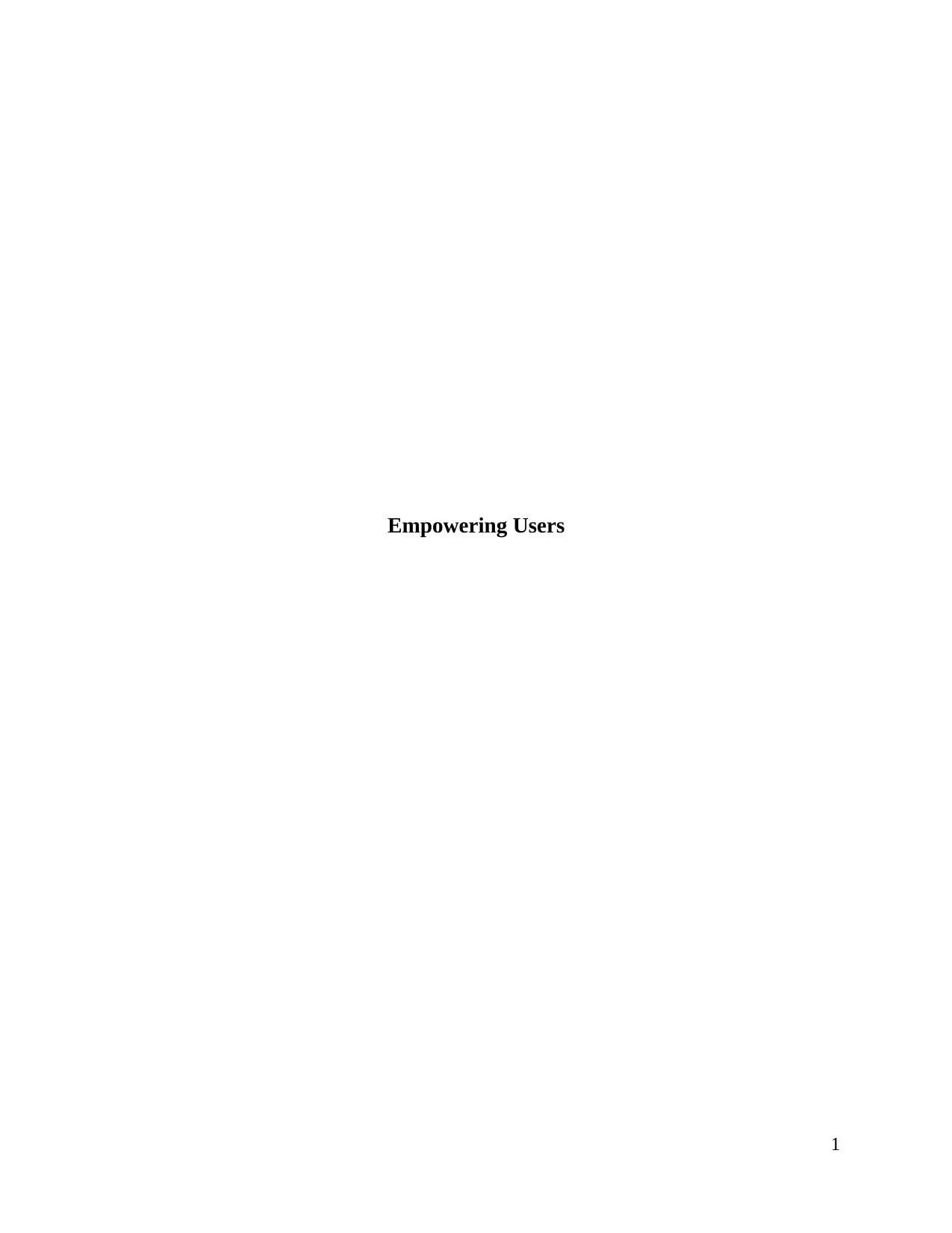
Empowering Users
1
1
Paraphrase This Document
Need a fresh take? Get an instant paraphrase of this document with our AI Paraphraser
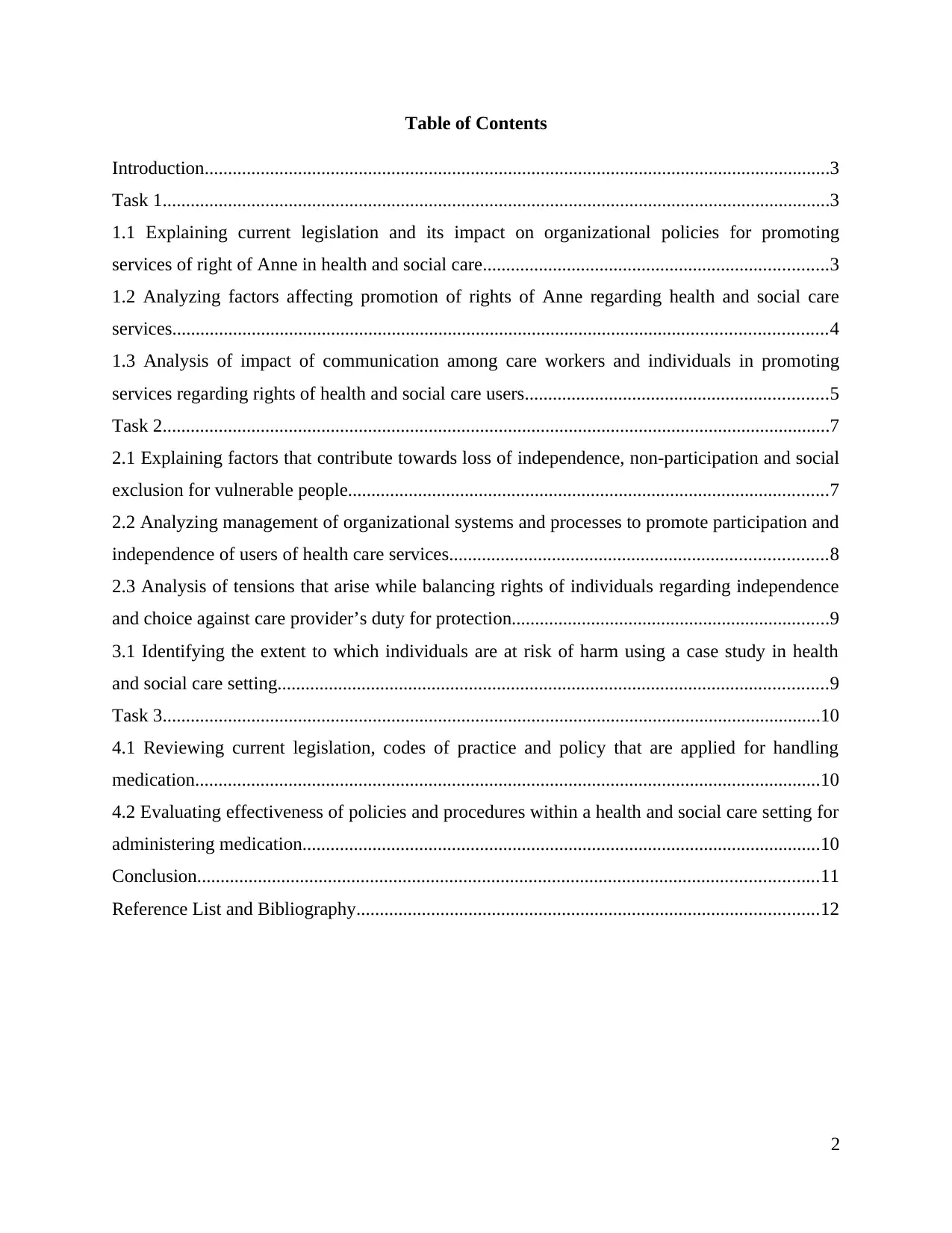
Table of Contents
Introduction......................................................................................................................................3
Task 1...............................................................................................................................................3
1.1 Explaining current legislation and its impact on organizational policies for promoting
services of right of Anne in health and social care..........................................................................3
1.2 Analyzing factors affecting promotion of rights of Anne regarding health and social care
services............................................................................................................................................4
1.3 Analysis of impact of communication among care workers and individuals in promoting
services regarding rights of health and social care users.................................................................5
Task 2...............................................................................................................................................7
2.1 Explaining factors that contribute towards loss of independence, non-participation and social
exclusion for vulnerable people.......................................................................................................7
2.2 Analyzing management of organizational systems and processes to promote participation and
independence of users of health care services.................................................................................8
2.3 Analysis of tensions that arise while balancing rights of individuals regarding independence
and choice against care provider’s duty for protection....................................................................9
3.1 Identifying the extent to which individuals are at risk of harm using a case study in health
and social care setting......................................................................................................................9
Task 3.............................................................................................................................................10
4.1 Reviewing current legislation, codes of practice and policy that are applied for handling
medication......................................................................................................................................10
4.2 Evaluating effectiveness of policies and procedures within a health and social care setting for
administering medication...............................................................................................................10
Conclusion.....................................................................................................................................11
Reference List and Bibliography...................................................................................................12
2
Introduction......................................................................................................................................3
Task 1...............................................................................................................................................3
1.1 Explaining current legislation and its impact on organizational policies for promoting
services of right of Anne in health and social care..........................................................................3
1.2 Analyzing factors affecting promotion of rights of Anne regarding health and social care
services............................................................................................................................................4
1.3 Analysis of impact of communication among care workers and individuals in promoting
services regarding rights of health and social care users.................................................................5
Task 2...............................................................................................................................................7
2.1 Explaining factors that contribute towards loss of independence, non-participation and social
exclusion for vulnerable people.......................................................................................................7
2.2 Analyzing management of organizational systems and processes to promote participation and
independence of users of health care services.................................................................................8
2.3 Analysis of tensions that arise while balancing rights of individuals regarding independence
and choice against care provider’s duty for protection....................................................................9
3.1 Identifying the extent to which individuals are at risk of harm using a case study in health
and social care setting......................................................................................................................9
Task 3.............................................................................................................................................10
4.1 Reviewing current legislation, codes of practice and policy that are applied for handling
medication......................................................................................................................................10
4.2 Evaluating effectiveness of policies and procedures within a health and social care setting for
administering medication...............................................................................................................10
Conclusion.....................................................................................................................................11
Reference List and Bibliography...................................................................................................12
2
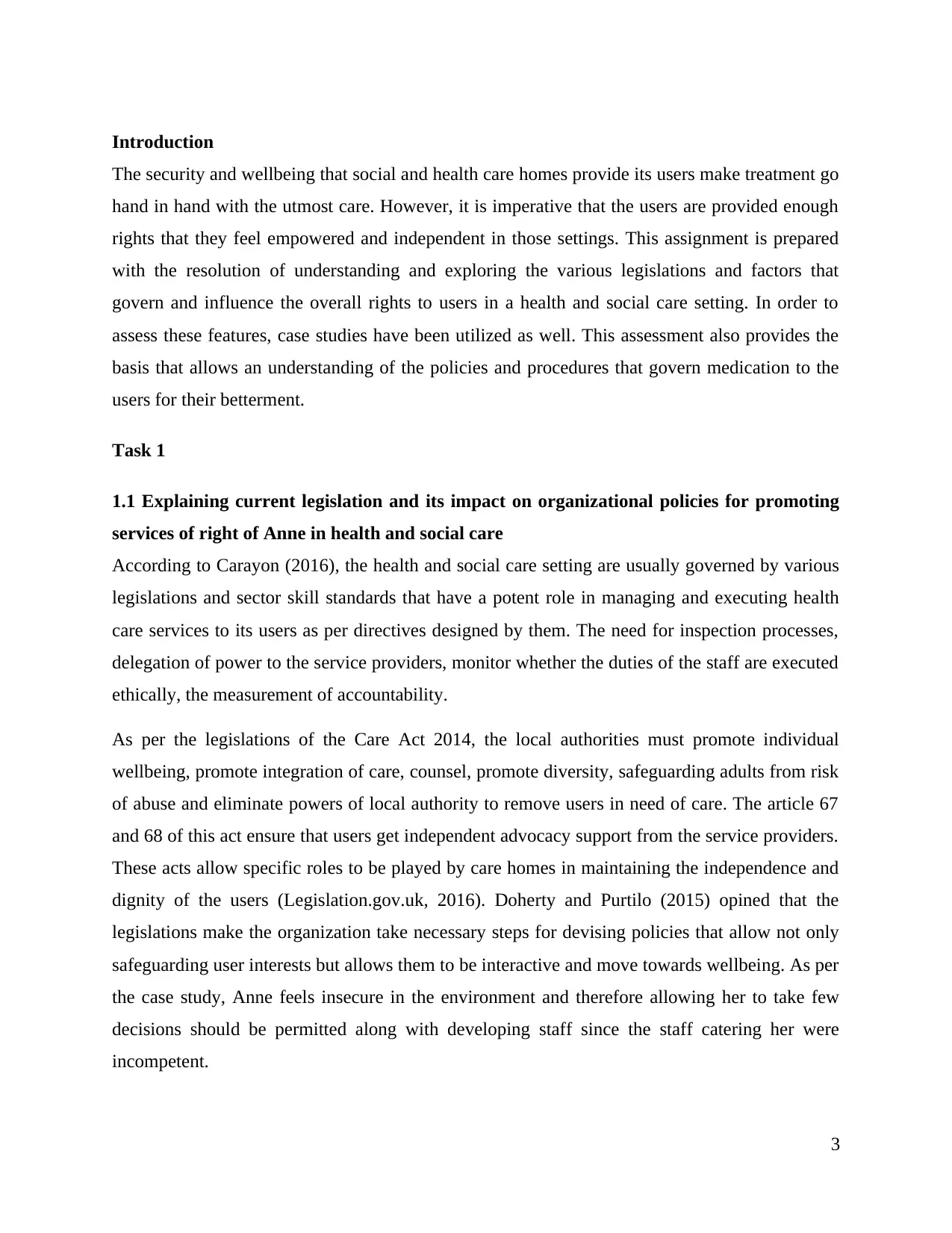
Introduction
The security and wellbeing that social and health care homes provide its users make treatment go
hand in hand with the utmost care. However, it is imperative that the users are provided enough
rights that they feel empowered and independent in those settings. This assignment is prepared
with the resolution of understanding and exploring the various legislations and factors that
govern and influence the overall rights to users in a health and social care setting. In order to
assess these features, case studies have been utilized as well. This assessment also provides the
basis that allows an understanding of the policies and procedures that govern medication to the
users for their betterment.
Task 1
1.1 Explaining current legislation and its impact on organizational policies for promoting
services of right of Anne in health and social care
According to Carayon (2016), the health and social care setting are usually governed by various
legislations and sector skill standards that have a potent role in managing and executing health
care services to its users as per directives designed by them. The need for inspection processes,
delegation of power to the service providers, monitor whether the duties of the staff are executed
ethically, the measurement of accountability.
As per the legislations of the Care Act 2014, the local authorities must promote individual
wellbeing, promote integration of care, counsel, promote diversity, safeguarding adults from risk
of abuse and eliminate powers of local authority to remove users in need of care. The article 67
and 68 of this act ensure that users get independent advocacy support from the service providers.
These acts allow specific roles to be played by care homes in maintaining the independence and
dignity of the users (Legislation.gov.uk, 2016). Doherty and Purtilo (2015) opined that the
legislations make the organization take necessary steps for devising policies that allow not only
safeguarding user interests but allows them to be interactive and move towards wellbeing. As per
the case study, Anne feels insecure in the environment and therefore allowing her to take few
decisions should be permitted along with developing staff since the staff catering her were
incompetent.
3
The security and wellbeing that social and health care homes provide its users make treatment go
hand in hand with the utmost care. However, it is imperative that the users are provided enough
rights that they feel empowered and independent in those settings. This assignment is prepared
with the resolution of understanding and exploring the various legislations and factors that
govern and influence the overall rights to users in a health and social care setting. In order to
assess these features, case studies have been utilized as well. This assessment also provides the
basis that allows an understanding of the policies and procedures that govern medication to the
users for their betterment.
Task 1
1.1 Explaining current legislation and its impact on organizational policies for promoting
services of right of Anne in health and social care
According to Carayon (2016), the health and social care setting are usually governed by various
legislations and sector skill standards that have a potent role in managing and executing health
care services to its users as per directives designed by them. The need for inspection processes,
delegation of power to the service providers, monitor whether the duties of the staff are executed
ethically, the measurement of accountability.
As per the legislations of the Care Act 2014, the local authorities must promote individual
wellbeing, promote integration of care, counsel, promote diversity, safeguarding adults from risk
of abuse and eliminate powers of local authority to remove users in need of care. The article 67
and 68 of this act ensure that users get independent advocacy support from the service providers.
These acts allow specific roles to be played by care homes in maintaining the independence and
dignity of the users (Legislation.gov.uk, 2016). Doherty and Purtilo (2015) opined that the
legislations make the organization take necessary steps for devising policies that allow not only
safeguarding user interests but allows them to be interactive and move towards wellbeing. As per
the case study, Anne feels insecure in the environment and therefore allowing her to take few
decisions should be permitted along with developing staff since the staff catering her were
incompetent.
3
⊘ This is a preview!⊘
Do you want full access?
Subscribe today to unlock all pages.

Trusted by 1+ million students worldwide
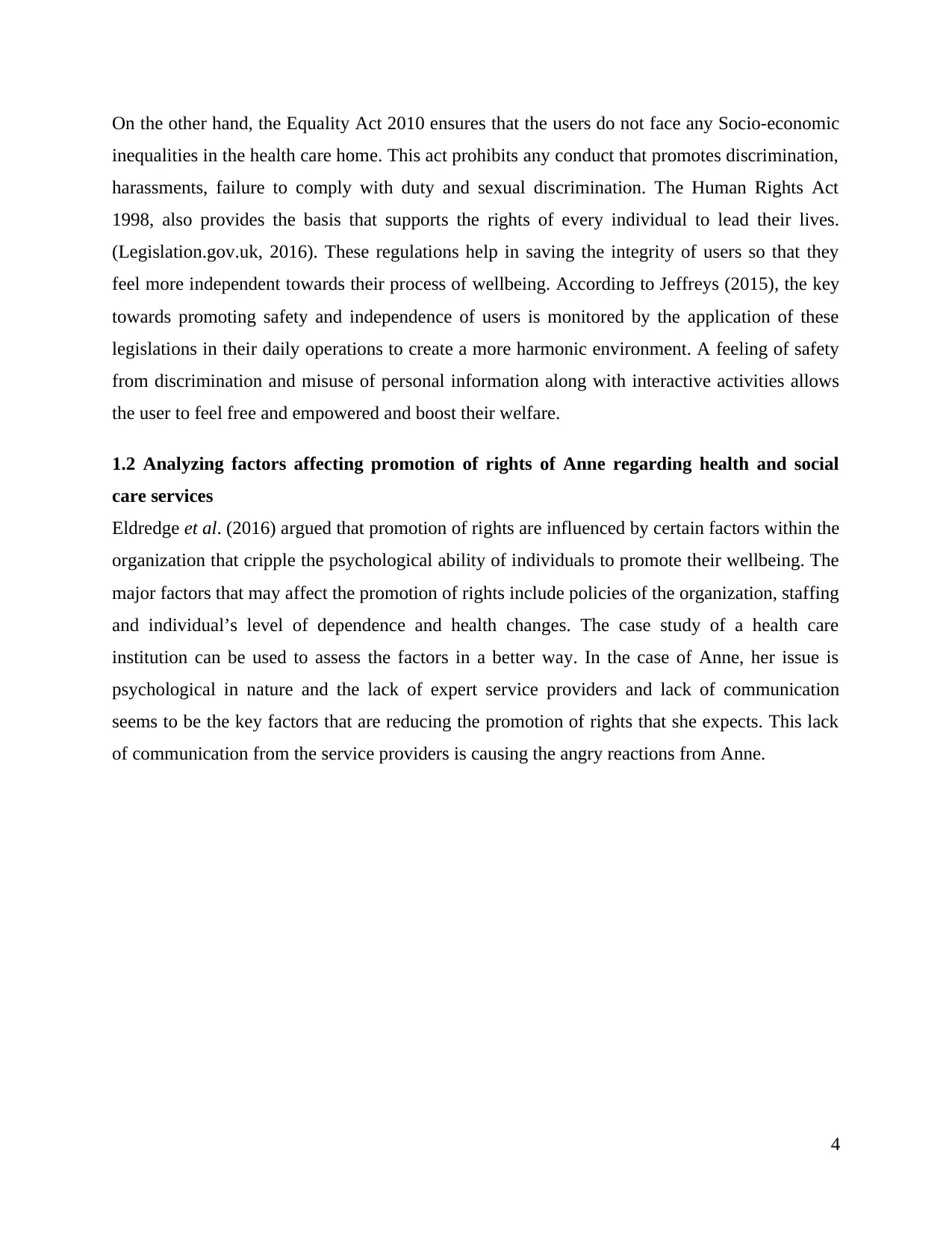
On the other hand, the Equality Act 2010 ensures that the users do not face any Socio-economic
inequalities in the health care home. This act prohibits any conduct that promotes discrimination,
harassments, failure to comply with duty and sexual discrimination. The Human Rights Act
1998, also provides the basis that supports the rights of every individual to lead their lives.
(Legislation.gov.uk, 2016). These regulations help in saving the integrity of users so that they
feel more independent towards their process of wellbeing. According to Jeffreys (2015), the key
towards promoting safety and independence of users is monitored by the application of these
legislations in their daily operations to create a more harmonic environment. A feeling of safety
from discrimination and misuse of personal information along with interactive activities allows
the user to feel free and empowered and boost their welfare.
1.2 Analyzing factors affecting promotion of rights of Anne regarding health and social
care services
Eldredge et al. (2016) argued that promotion of rights are influenced by certain factors within the
organization that cripple the psychological ability of individuals to promote their wellbeing. The
major factors that may affect the promotion of rights include policies of the organization, staffing
and individual’s level of dependence and health changes. The case study of a health care
institution can be used to assess the factors in a better way. In the case of Anne, her issue is
psychological in nature and the lack of expert service providers and lack of communication
seems to be the key factors that are reducing the promotion of rights that she expects. This lack
of communication from the service providers is causing the angry reactions from Anne.
4
inequalities in the health care home. This act prohibits any conduct that promotes discrimination,
harassments, failure to comply with duty and sexual discrimination. The Human Rights Act
1998, also provides the basis that supports the rights of every individual to lead their lives.
(Legislation.gov.uk, 2016). These regulations help in saving the integrity of users so that they
feel more independent towards their process of wellbeing. According to Jeffreys (2015), the key
towards promoting safety and independence of users is monitored by the application of these
legislations in their daily operations to create a more harmonic environment. A feeling of safety
from discrimination and misuse of personal information along with interactive activities allows
the user to feel free and empowered and boost their welfare.
1.2 Analyzing factors affecting promotion of rights of Anne regarding health and social
care services
Eldredge et al. (2016) argued that promotion of rights are influenced by certain factors within the
organization that cripple the psychological ability of individuals to promote their wellbeing. The
major factors that may affect the promotion of rights include policies of the organization, staffing
and individual’s level of dependence and health changes. The case study of a health care
institution can be used to assess the factors in a better way. In the case of Anne, her issue is
psychological in nature and the lack of expert service providers and lack of communication
seems to be the key factors that are reducing the promotion of rights that she expects. This lack
of communication from the service providers is causing the angry reactions from Anne.
4
Paraphrase This Document
Need a fresh take? Get an instant paraphrase of this document with our AI Paraphraser
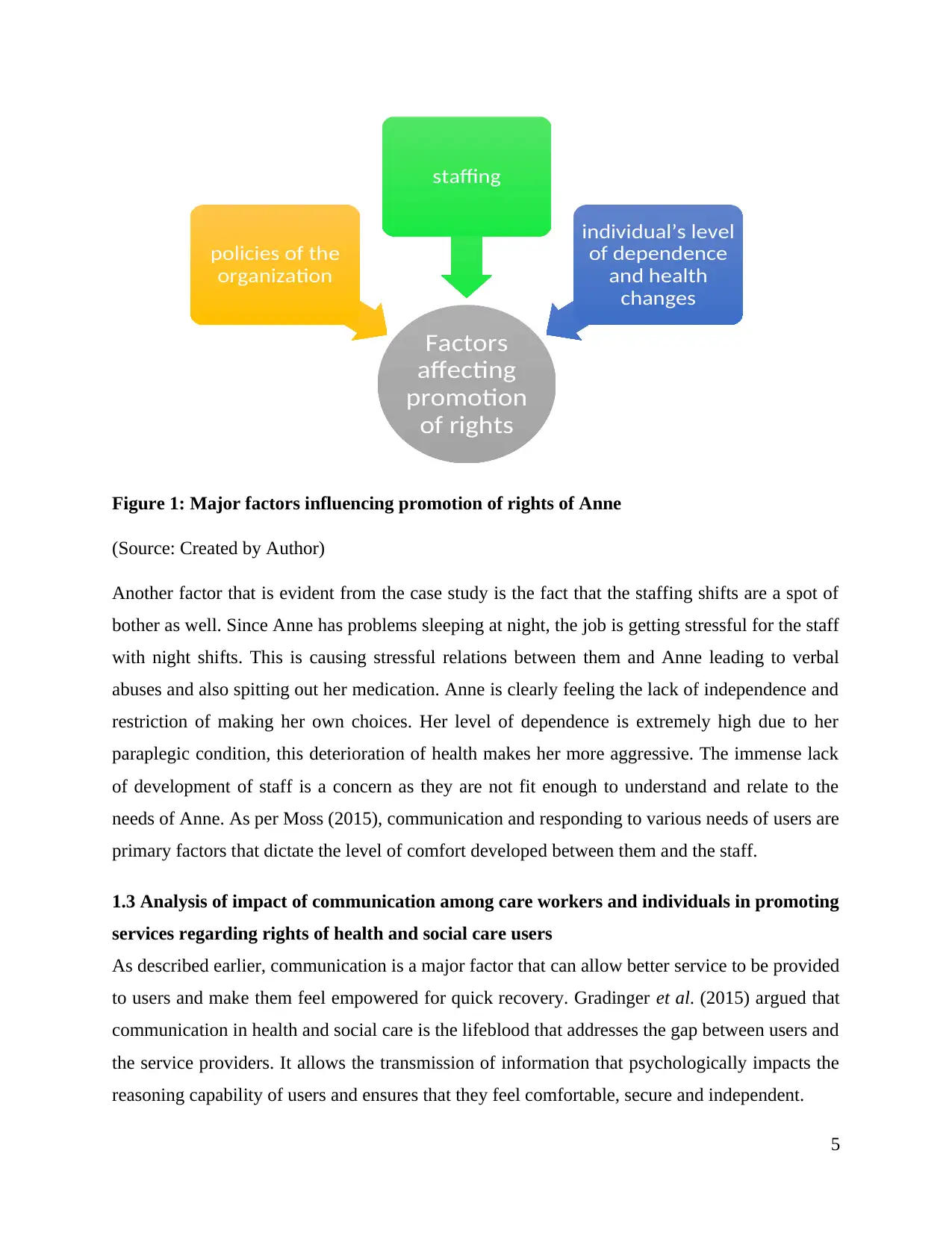
Figure 1: Major factors influencing promotion of rights of Anne
(Source: Created by Author)
Another factor that is evident from the case study is the fact that the staffing shifts are a spot of
bother as well. Since Anne has problems sleeping at night, the job is getting stressful for the staff
with night shifts. This is causing stressful relations between them and Anne leading to verbal
abuses and also spitting out her medication. Anne is clearly feeling the lack of independence and
restriction of making her own choices. Her level of dependence is extremely high due to her
paraplegic condition, this deterioration of health makes her more aggressive. The immense lack
of development of staff is a concern as they are not fit enough to understand and relate to the
needs of Anne. As per Moss (2015), communication and responding to various needs of users are
primary factors that dictate the level of comfort developed between them and the staff.
1.3 Analysis of impact of communication among care workers and individuals in promoting
services regarding rights of health and social care users
As described earlier, communication is a major factor that can allow better service to be provided
to users and make them feel empowered for quick recovery. Gradinger et al. (2015) argued that
communication in health and social care is the lifeblood that addresses the gap between users and
the service providers. It allows the transmission of information that psychologically impacts the
reasoning capability of users and ensures that they feel comfortable, secure and independent.
5
Factors
affecting
promotion
of rights
policies of the
organization
staffing
individual’s level
of dependence
and health
changes
(Source: Created by Author)
Another factor that is evident from the case study is the fact that the staffing shifts are a spot of
bother as well. Since Anne has problems sleeping at night, the job is getting stressful for the staff
with night shifts. This is causing stressful relations between them and Anne leading to verbal
abuses and also spitting out her medication. Anne is clearly feeling the lack of independence and
restriction of making her own choices. Her level of dependence is extremely high due to her
paraplegic condition, this deterioration of health makes her more aggressive. The immense lack
of development of staff is a concern as they are not fit enough to understand and relate to the
needs of Anne. As per Moss (2015), communication and responding to various needs of users are
primary factors that dictate the level of comfort developed between them and the staff.
1.3 Analysis of impact of communication among care workers and individuals in promoting
services regarding rights of health and social care users
As described earlier, communication is a major factor that can allow better service to be provided
to users and make them feel empowered for quick recovery. Gradinger et al. (2015) argued that
communication in health and social care is the lifeblood that addresses the gap between users and
the service providers. It allows the transmission of information that psychologically impacts the
reasoning capability of users and ensures that they feel comfortable, secure and independent.
5
Factors
affecting
promotion
of rights
policies of the
organization
staffing
individual’s level
of dependence
and health
changes
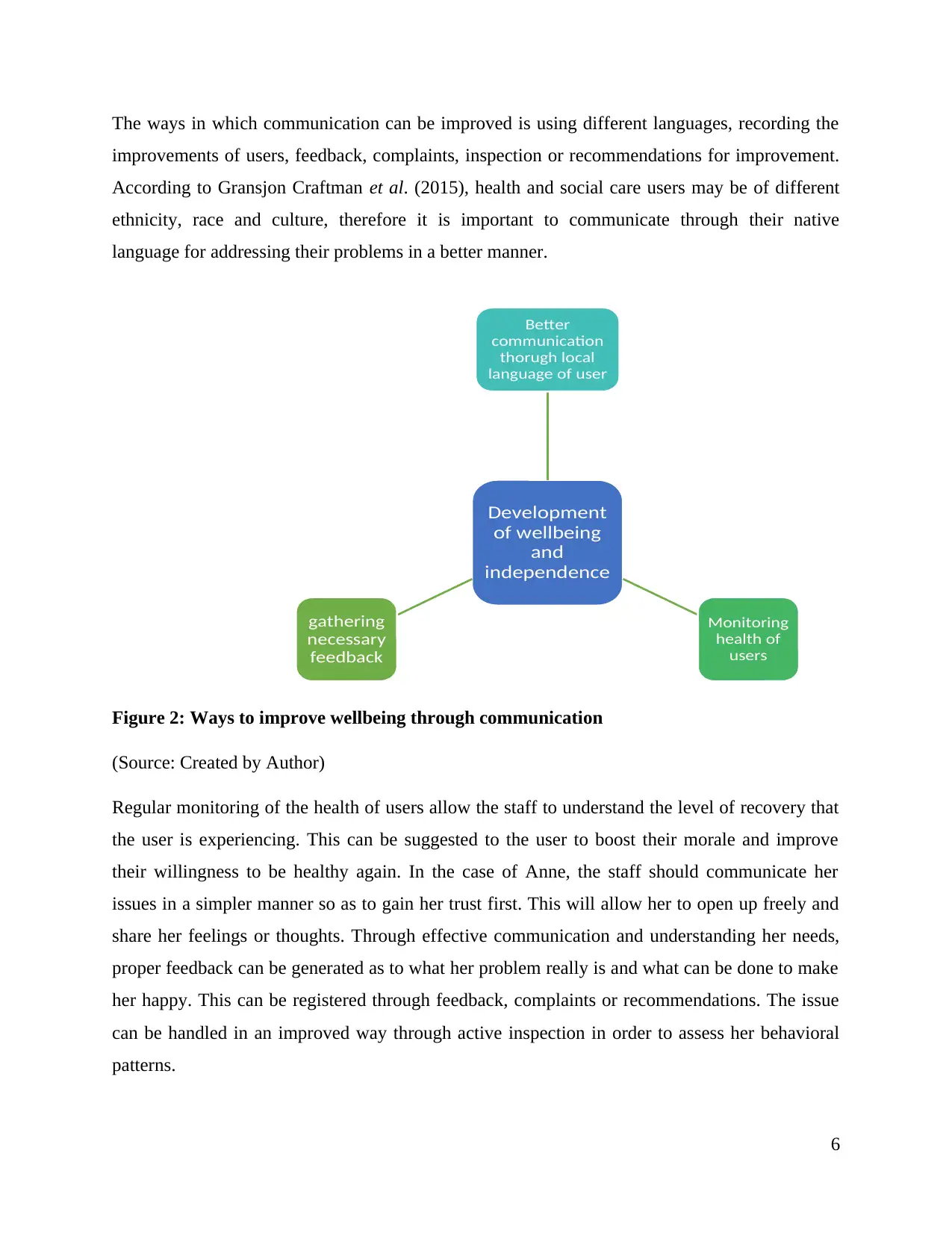
The ways in which communication can be improved is using different languages, recording the
improvements of users, feedback, complaints, inspection or recommendations for improvement.
According to Gransjon Craftman et al. (2015), health and social care users may be of different
ethnicity, race and culture, therefore it is important to communicate through their native
language for addressing their problems in a better manner.
Figure 2: Ways to improve wellbeing through communication
(Source: Created by Author)
Regular monitoring of the health of users allow the staff to understand the level of recovery that
the user is experiencing. This can be suggested to the user to boost their morale and improve
their willingness to be healthy again. In the case of Anne, the staff should communicate her
issues in a simpler manner so as to gain her trust first. This will allow her to open up freely and
share her feelings or thoughts. Through effective communication and understanding her needs,
proper feedback can be generated as to what her problem really is and what can be done to make
her happy. This can be registered through feedback, complaints or recommendations. The issue
can be handled in an improved way through active inspection in order to assess her behavioral
patterns.
6
Development
of wellbeing
and
independence
Better
communication
thorugh local
language of user
Monitoring
health of
users
gathering
necessary
feedback
improvements of users, feedback, complaints, inspection or recommendations for improvement.
According to Gransjon Craftman et al. (2015), health and social care users may be of different
ethnicity, race and culture, therefore it is important to communicate through their native
language for addressing their problems in a better manner.
Figure 2: Ways to improve wellbeing through communication
(Source: Created by Author)
Regular monitoring of the health of users allow the staff to understand the level of recovery that
the user is experiencing. This can be suggested to the user to boost their morale and improve
their willingness to be healthy again. In the case of Anne, the staff should communicate her
issues in a simpler manner so as to gain her trust first. This will allow her to open up freely and
share her feelings or thoughts. Through effective communication and understanding her needs,
proper feedback can be generated as to what her problem really is and what can be done to make
her happy. This can be registered through feedback, complaints or recommendations. The issue
can be handled in an improved way through active inspection in order to assess her behavioral
patterns.
6
Development
of wellbeing
and
independence
Better
communication
thorugh local
language of user
Monitoring
health of
users
gathering
necessary
feedback
⊘ This is a preview!⊘
Do you want full access?
Subscribe today to unlock all pages.

Trusted by 1+ million students worldwide
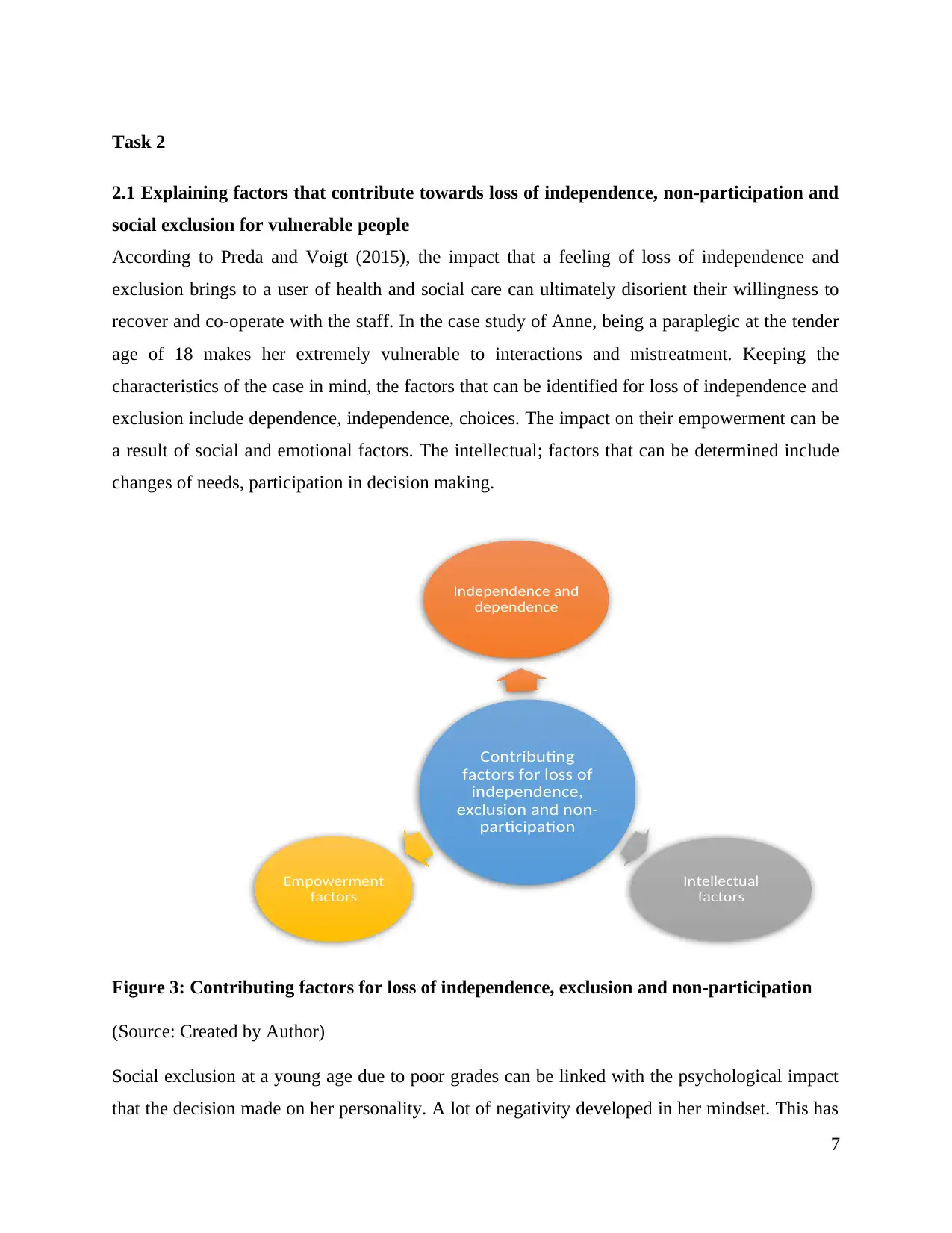
Task 2
2.1 Explaining factors that contribute towards loss of independence, non-participation and
social exclusion for vulnerable people
According to Preda and Voigt (2015), the impact that a feeling of loss of independence and
exclusion brings to a user of health and social care can ultimately disorient their willingness to
recover and co-operate with the staff. In the case study of Anne, being a paraplegic at the tender
age of 18 makes her extremely vulnerable to interactions and mistreatment. Keeping the
characteristics of the case in mind, the factors that can be identified for loss of independence and
exclusion include dependence, independence, choices. The impact on their empowerment can be
a result of social and emotional factors. The intellectual; factors that can be determined include
changes of needs, participation in decision making.
Figure 3: Contributing factors for loss of independence, exclusion and non-participation
(Source: Created by Author)
Social exclusion at a young age due to poor grades can be linked with the psychological impact
that the decision made on her personality. A lot of negativity developed in her mindset. This has
7
Contributing
factors for loss of
independence,
exclusion and non-
participation
Independence and
dependence
Intellectual
factors
Empowerment
factors
2.1 Explaining factors that contribute towards loss of independence, non-participation and
social exclusion for vulnerable people
According to Preda and Voigt (2015), the impact that a feeling of loss of independence and
exclusion brings to a user of health and social care can ultimately disorient their willingness to
recover and co-operate with the staff. In the case study of Anne, being a paraplegic at the tender
age of 18 makes her extremely vulnerable to interactions and mistreatment. Keeping the
characteristics of the case in mind, the factors that can be identified for loss of independence and
exclusion include dependence, independence, choices. The impact on their empowerment can be
a result of social and emotional factors. The intellectual; factors that can be determined include
changes of needs, participation in decision making.
Figure 3: Contributing factors for loss of independence, exclusion and non-participation
(Source: Created by Author)
Social exclusion at a young age due to poor grades can be linked with the psychological impact
that the decision made on her personality. A lot of negativity developed in her mindset. This has
7
Contributing
factors for loss of
independence,
exclusion and non-
participation
Independence and
dependence
Intellectual
factors
Empowerment
factors
Paraphrase This Document
Need a fresh take? Get an instant paraphrase of this document with our AI Paraphraser
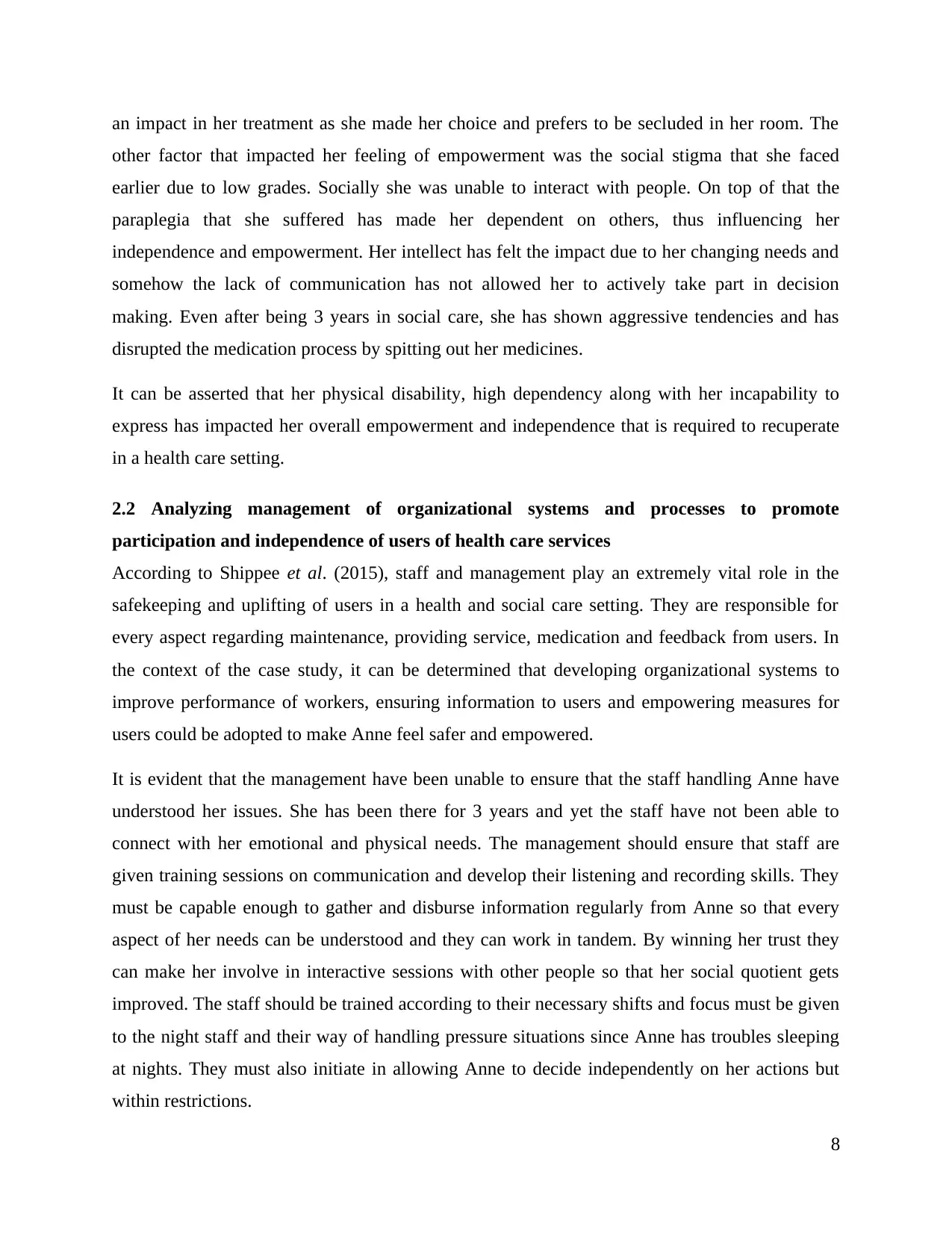
an impact in her treatment as she made her choice and prefers to be secluded in her room. The
other factor that impacted her feeling of empowerment was the social stigma that she faced
earlier due to low grades. Socially she was unable to interact with people. On top of that the
paraplegia that she suffered has made her dependent on others, thus influencing her
independence and empowerment. Her intellect has felt the impact due to her changing needs and
somehow the lack of communication has not allowed her to actively take part in decision
making. Even after being 3 years in social care, she has shown aggressive tendencies and has
disrupted the medication process by spitting out her medicines.
It can be asserted that her physical disability, high dependency along with her incapability to
express has impacted her overall empowerment and independence that is required to recuperate
in a health care setting.
2.2 Analyzing management of organizational systems and processes to promote
participation and independence of users of health care services
According to Shippee et al. (2015), staff and management play an extremely vital role in the
safekeeping and uplifting of users in a health and social care setting. They are responsible for
every aspect regarding maintenance, providing service, medication and feedback from users. In
the context of the case study, it can be determined that developing organizational systems to
improve performance of workers, ensuring information to users and empowering measures for
users could be adopted to make Anne feel safer and empowered.
It is evident that the management have been unable to ensure that the staff handling Anne have
understood her issues. She has been there for 3 years and yet the staff have not been able to
connect with her emotional and physical needs. The management should ensure that staff are
given training sessions on communication and develop their listening and recording skills. They
must be capable enough to gather and disburse information regularly from Anne so that every
aspect of her needs can be understood and they can work in tandem. By winning her trust they
can make her involve in interactive sessions with other people so that her social quotient gets
improved. The staff should be trained according to their necessary shifts and focus must be given
to the night staff and their way of handling pressure situations since Anne has troubles sleeping
at nights. They must also initiate in allowing Anne to decide independently on her actions but
within restrictions.
8
other factor that impacted her feeling of empowerment was the social stigma that she faced
earlier due to low grades. Socially she was unable to interact with people. On top of that the
paraplegia that she suffered has made her dependent on others, thus influencing her
independence and empowerment. Her intellect has felt the impact due to her changing needs and
somehow the lack of communication has not allowed her to actively take part in decision
making. Even after being 3 years in social care, she has shown aggressive tendencies and has
disrupted the medication process by spitting out her medicines.
It can be asserted that her physical disability, high dependency along with her incapability to
express has impacted her overall empowerment and independence that is required to recuperate
in a health care setting.
2.2 Analyzing management of organizational systems and processes to promote
participation and independence of users of health care services
According to Shippee et al. (2015), staff and management play an extremely vital role in the
safekeeping and uplifting of users in a health and social care setting. They are responsible for
every aspect regarding maintenance, providing service, medication and feedback from users. In
the context of the case study, it can be determined that developing organizational systems to
improve performance of workers, ensuring information to users and empowering measures for
users could be adopted to make Anne feel safer and empowered.
It is evident that the management have been unable to ensure that the staff handling Anne have
understood her issues. She has been there for 3 years and yet the staff have not been able to
connect with her emotional and physical needs. The management should ensure that staff are
given training sessions on communication and develop their listening and recording skills. They
must be capable enough to gather and disburse information regularly from Anne so that every
aspect of her needs can be understood and they can work in tandem. By winning her trust they
can make her involve in interactive sessions with other people so that her social quotient gets
improved. The staff should be trained according to their necessary shifts and focus must be given
to the night staff and their way of handling pressure situations since Anne has troubles sleeping
at nights. They must also initiate in allowing Anne to decide independently on her actions but
within restrictions.
8
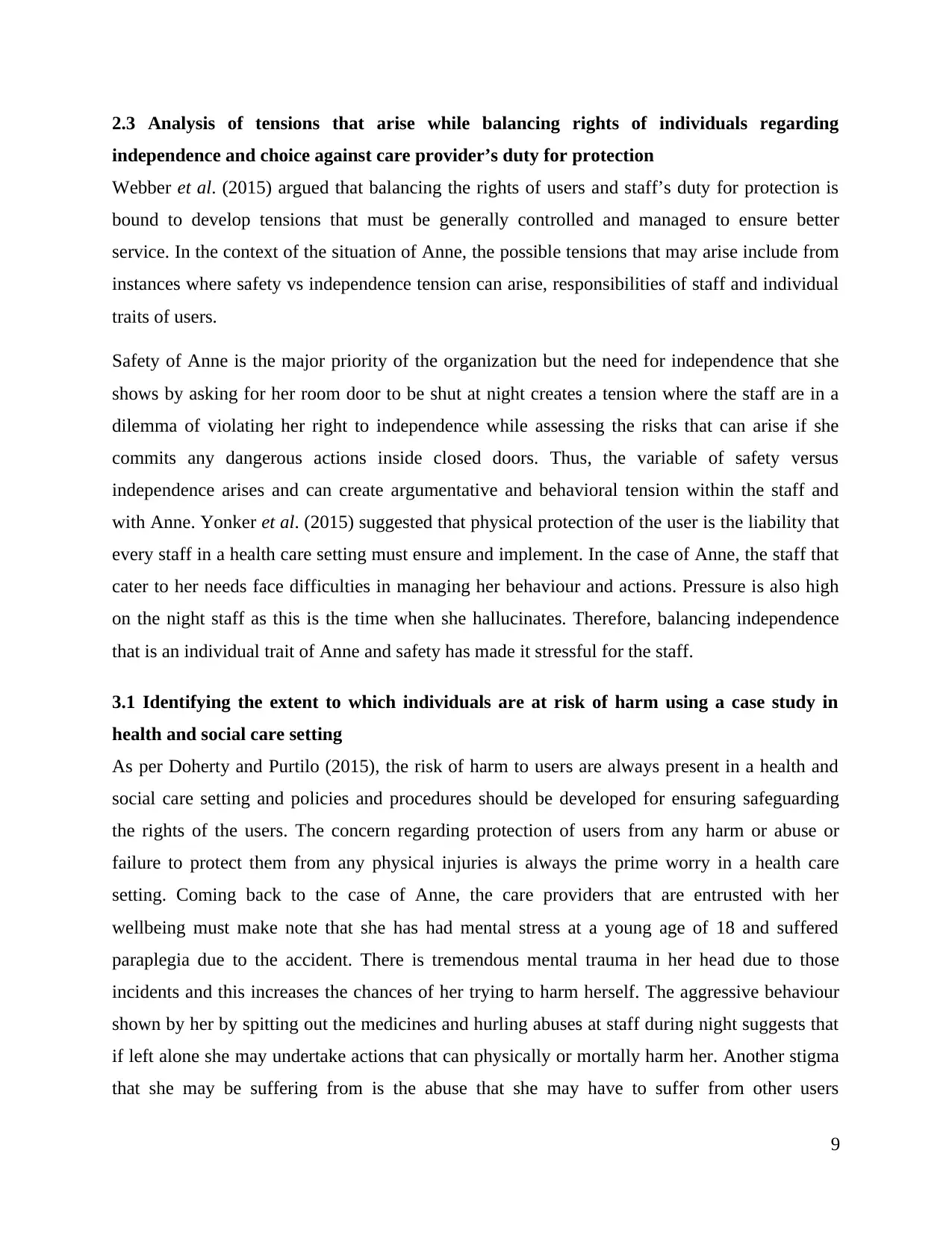
2.3 Analysis of tensions that arise while balancing rights of individuals regarding
independence and choice against care provider’s duty for protection
Webber et al. (2015) argued that balancing the rights of users and staff’s duty for protection is
bound to develop tensions that must be generally controlled and managed to ensure better
service. In the context of the situation of Anne, the possible tensions that may arise include from
instances where safety vs independence tension can arise, responsibilities of staff and individual
traits of users.
Safety of Anne is the major priority of the organization but the need for independence that she
shows by asking for her room door to be shut at night creates a tension where the staff are in a
dilemma of violating her right to independence while assessing the risks that can arise if she
commits any dangerous actions inside closed doors. Thus, the variable of safety versus
independence arises and can create argumentative and behavioral tension within the staff and
with Anne. Yonker et al. (2015) suggested that physical protection of the user is the liability that
every staff in a health care setting must ensure and implement. In the case of Anne, the staff that
cater to her needs face difficulties in managing her behaviour and actions. Pressure is also high
on the night staff as this is the time when she hallucinates. Therefore, balancing independence
that is an individual trait of Anne and safety has made it stressful for the staff.
3.1 Identifying the extent to which individuals are at risk of harm using a case study in
health and social care setting
As per Doherty and Purtilo (2015), the risk of harm to users are always present in a health and
social care setting and policies and procedures should be developed for ensuring safeguarding
the rights of the users. The concern regarding protection of users from any harm or abuse or
failure to protect them from any physical injuries is always the prime worry in a health care
setting. Coming back to the case of Anne, the care providers that are entrusted with her
wellbeing must make note that she has had mental stress at a young age of 18 and suffered
paraplegia due to the accident. There is tremendous mental trauma in her head due to those
incidents and this increases the chances of her trying to harm herself. The aggressive behaviour
shown by her by spitting out the medicines and hurling abuses at staff during night suggests that
if left alone she may undertake actions that can physically or mortally harm her. Another stigma
that she may be suffering from is the abuse that she may have to suffer from other users
9
independence and choice against care provider’s duty for protection
Webber et al. (2015) argued that balancing the rights of users and staff’s duty for protection is
bound to develop tensions that must be generally controlled and managed to ensure better
service. In the context of the situation of Anne, the possible tensions that may arise include from
instances where safety vs independence tension can arise, responsibilities of staff and individual
traits of users.
Safety of Anne is the major priority of the organization but the need for independence that she
shows by asking for her room door to be shut at night creates a tension where the staff are in a
dilemma of violating her right to independence while assessing the risks that can arise if she
commits any dangerous actions inside closed doors. Thus, the variable of safety versus
independence arises and can create argumentative and behavioral tension within the staff and
with Anne. Yonker et al. (2015) suggested that physical protection of the user is the liability that
every staff in a health care setting must ensure and implement. In the case of Anne, the staff that
cater to her needs face difficulties in managing her behaviour and actions. Pressure is also high
on the night staff as this is the time when she hallucinates. Therefore, balancing independence
that is an individual trait of Anne and safety has made it stressful for the staff.
3.1 Identifying the extent to which individuals are at risk of harm using a case study in
health and social care setting
As per Doherty and Purtilo (2015), the risk of harm to users are always present in a health and
social care setting and policies and procedures should be developed for ensuring safeguarding
the rights of the users. The concern regarding protection of users from any harm or abuse or
failure to protect them from any physical injuries is always the prime worry in a health care
setting. Coming back to the case of Anne, the care providers that are entrusted with her
wellbeing must make note that she has had mental stress at a young age of 18 and suffered
paraplegia due to the accident. There is tremendous mental trauma in her head due to those
incidents and this increases the chances of her trying to harm herself. The aggressive behaviour
shown by her by spitting out the medicines and hurling abuses at staff during night suggests that
if left alone she may undertake actions that can physically or mortally harm her. Another stigma
that she may be suffering from is the abuse that she may have to suffer from other users
9
⊘ This is a preview!⊘
Do you want full access?
Subscribe today to unlock all pages.

Trusted by 1+ million students worldwide
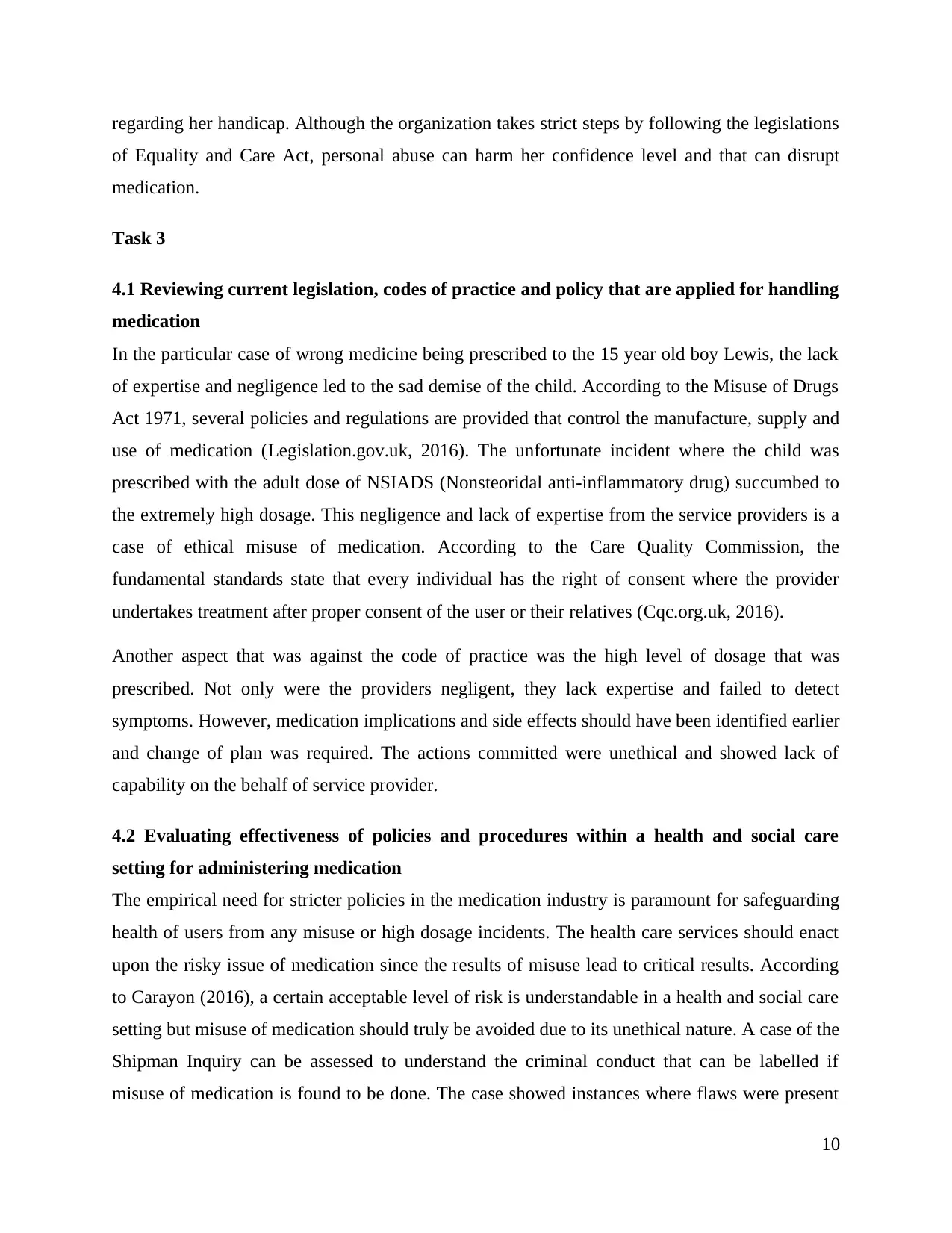
regarding her handicap. Although the organization takes strict steps by following the legislations
of Equality and Care Act, personal abuse can harm her confidence level and that can disrupt
medication.
Task 3
4.1 Reviewing current legislation, codes of practice and policy that are applied for handling
medication
In the particular case of wrong medicine being prescribed to the 15 year old boy Lewis, the lack
of expertise and negligence led to the sad demise of the child. According to the Misuse of Drugs
Act 1971, several policies and regulations are provided that control the manufacture, supply and
use of medication (Legislation.gov.uk, 2016). The unfortunate incident where the child was
prescribed with the adult dose of NSIADS (Nonsteoridal anti-inflammatory drug) succumbed to
the extremely high dosage. This negligence and lack of expertise from the service providers is a
case of ethical misuse of medication. According to the Care Quality Commission, the
fundamental standards state that every individual has the right of consent where the provider
undertakes treatment after proper consent of the user or their relatives (Cqc.org.uk, 2016).
Another aspect that was against the code of practice was the high level of dosage that was
prescribed. Not only were the providers negligent, they lack expertise and failed to detect
symptoms. However, medication implications and side effects should have been identified earlier
and change of plan was required. The actions committed were unethical and showed lack of
capability on the behalf of service provider.
4.2 Evaluating effectiveness of policies and procedures within a health and social care
setting for administering medication
The empirical need for stricter policies in the medication industry is paramount for safeguarding
health of users from any misuse or high dosage incidents. The health care services should enact
upon the risky issue of medication since the results of misuse lead to critical results. According
to Carayon (2016), a certain acceptable level of risk is understandable in a health and social care
setting but misuse of medication should truly be avoided due to its unethical nature. A case of the
Shipman Inquiry can be assessed to understand the criminal conduct that can be labelled if
misuse of medication is found to be done. The case showed instances where flaws were present
10
of Equality and Care Act, personal abuse can harm her confidence level and that can disrupt
medication.
Task 3
4.1 Reviewing current legislation, codes of practice and policy that are applied for handling
medication
In the particular case of wrong medicine being prescribed to the 15 year old boy Lewis, the lack
of expertise and negligence led to the sad demise of the child. According to the Misuse of Drugs
Act 1971, several policies and regulations are provided that control the manufacture, supply and
use of medication (Legislation.gov.uk, 2016). The unfortunate incident where the child was
prescribed with the adult dose of NSIADS (Nonsteoridal anti-inflammatory drug) succumbed to
the extremely high dosage. This negligence and lack of expertise from the service providers is a
case of ethical misuse of medication. According to the Care Quality Commission, the
fundamental standards state that every individual has the right of consent where the provider
undertakes treatment after proper consent of the user or their relatives (Cqc.org.uk, 2016).
Another aspect that was against the code of practice was the high level of dosage that was
prescribed. Not only were the providers negligent, they lack expertise and failed to detect
symptoms. However, medication implications and side effects should have been identified earlier
and change of plan was required. The actions committed were unethical and showed lack of
capability on the behalf of service provider.
4.2 Evaluating effectiveness of policies and procedures within a health and social care
setting for administering medication
The empirical need for stricter policies in the medication industry is paramount for safeguarding
health of users from any misuse or high dosage incidents. The health care services should enact
upon the risky issue of medication since the results of misuse lead to critical results. According
to Carayon (2016), a certain acceptable level of risk is understandable in a health and social care
setting but misuse of medication should truly be avoided due to its unethical nature. A case of the
Shipman Inquiry can be assessed to understand the criminal conduct that can be labelled if
misuse of medication is found to be done. The case showed instances where flaws were present
10
Paraphrase This Document
Need a fresh take? Get an instant paraphrase of this document with our AI Paraphraser
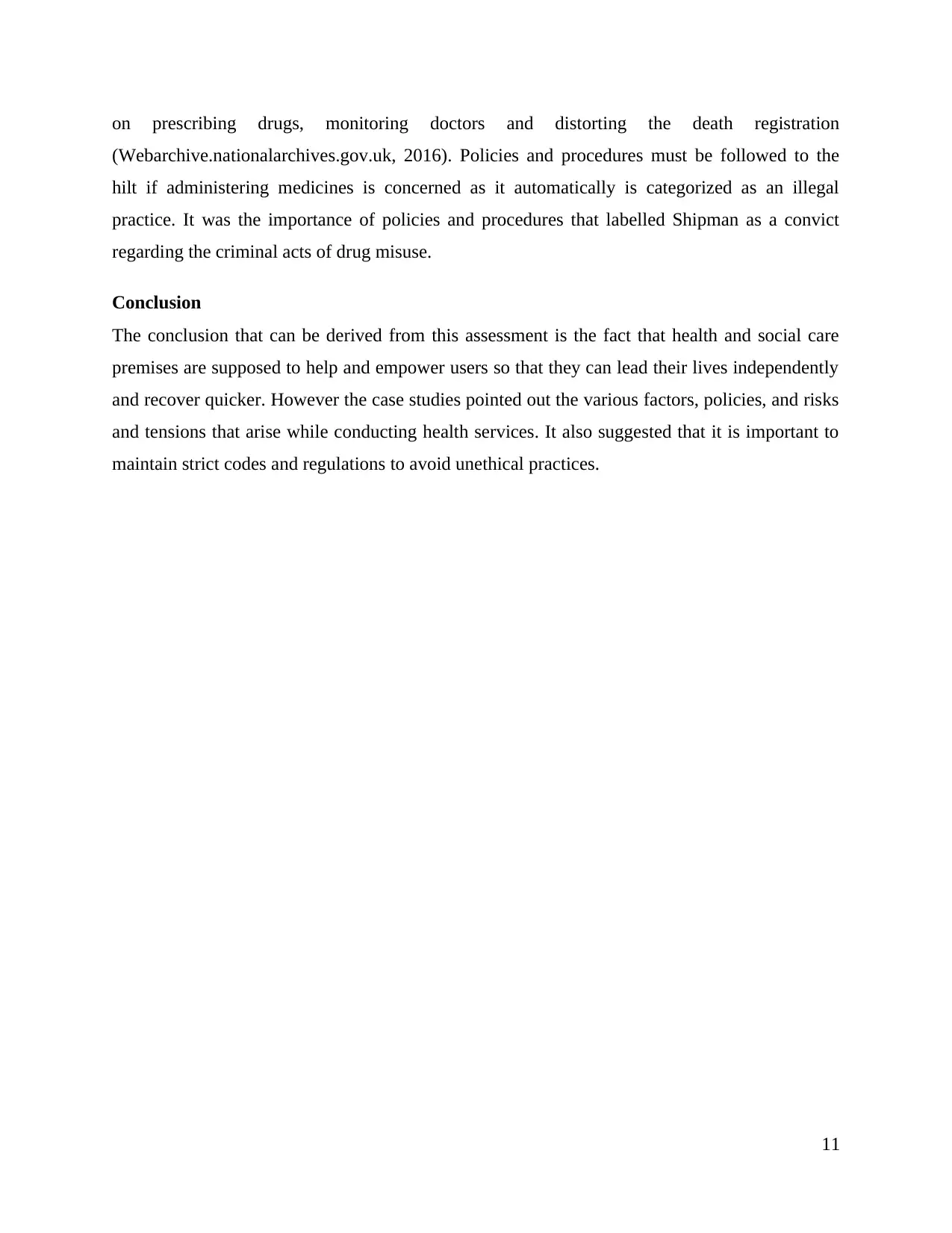
on prescribing drugs, monitoring doctors and distorting the death registration
(Webarchive.nationalarchives.gov.uk, 2016). Policies and procedures must be followed to the
hilt if administering medicines is concerned as it automatically is categorized as an illegal
practice. It was the importance of policies and procedures that labelled Shipman as a convict
regarding the criminal acts of drug misuse.
Conclusion
The conclusion that can be derived from this assessment is the fact that health and social care
premises are supposed to help and empower users so that they can lead their lives independently
and recover quicker. However the case studies pointed out the various factors, policies, and risks
and tensions that arise while conducting health services. It also suggested that it is important to
maintain strict codes and regulations to avoid unethical practices.
11
(Webarchive.nationalarchives.gov.uk, 2016). Policies and procedures must be followed to the
hilt if administering medicines is concerned as it automatically is categorized as an illegal
practice. It was the importance of policies and procedures that labelled Shipman as a convict
regarding the criminal acts of drug misuse.
Conclusion
The conclusion that can be derived from this assessment is the fact that health and social care
premises are supposed to help and empower users so that they can lead their lives independently
and recover quicker. However the case studies pointed out the various factors, policies, and risks
and tensions that arise while conducting health services. It also suggested that it is important to
maintain strict codes and regulations to avoid unethical practices.
11
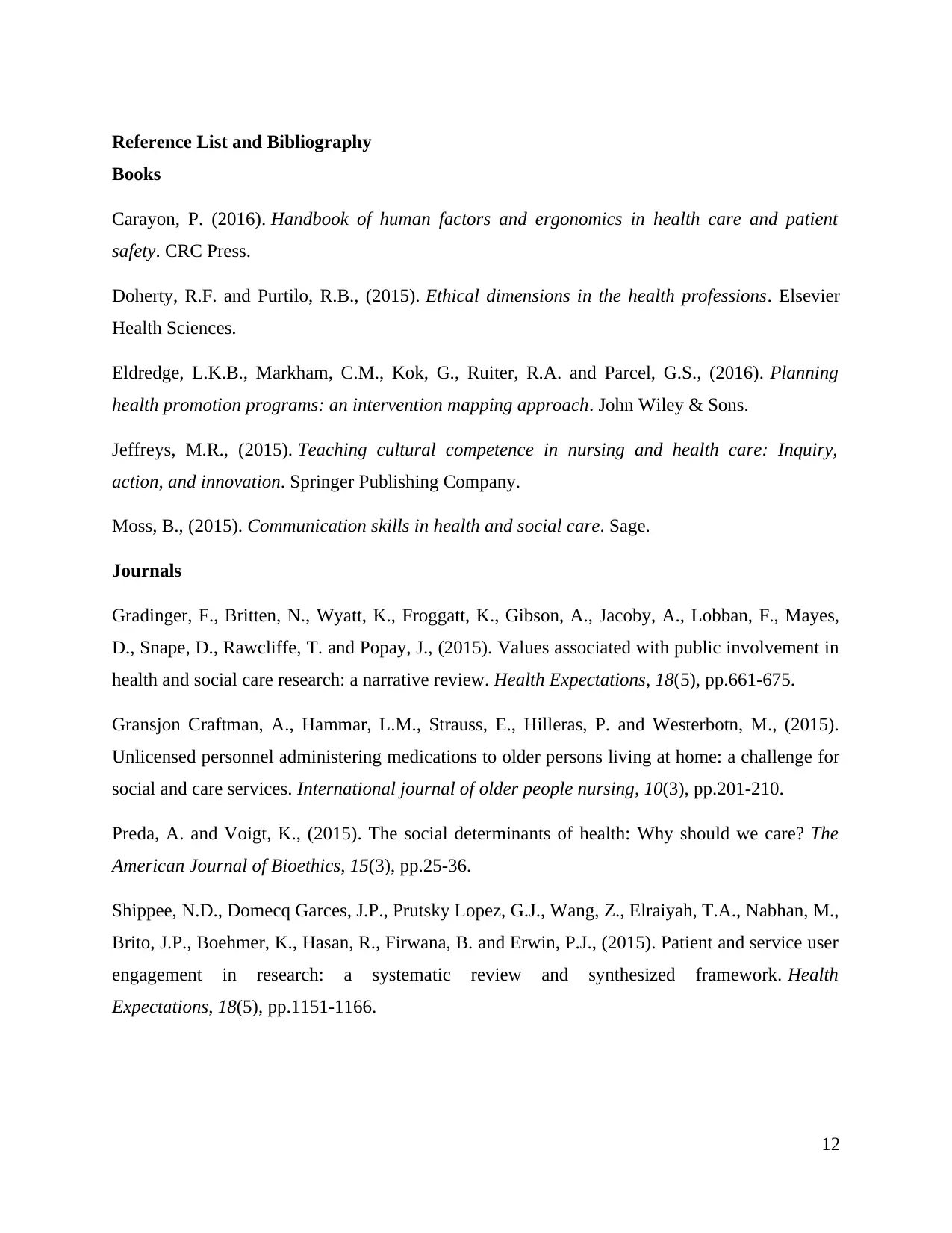
Reference List and Bibliography
Books
Carayon, P. (2016). Handbook of human factors and ergonomics in health care and patient
safety. CRC Press.
Doherty, R.F. and Purtilo, R.B., (2015). Ethical dimensions in the health professions. Elsevier
Health Sciences.
Eldredge, L.K.B., Markham, C.M., Kok, G., Ruiter, R.A. and Parcel, G.S., (2016). Planning
health promotion programs: an intervention mapping approach. John Wiley & Sons.
Jeffreys, M.R., (2015). Teaching cultural competence in nursing and health care: Inquiry,
action, and innovation. Springer Publishing Company.
Moss, B., (2015). Communication skills in health and social care. Sage.
Journals
Gradinger, F., Britten, N., Wyatt, K., Froggatt, K., Gibson, A., Jacoby, A., Lobban, F., Mayes,
D., Snape, D., Rawcliffe, T. and Popay, J., (2015). Values associated with public involvement in
health and social care research: a narrative review. Health Expectations, 18(5), pp.661-675.
Gransjon Craftman, A., Hammar, L.M., Strauss, E., Hilleras, P. and Westerbotn, M., (2015).
Unlicensed personnel administering medications to older persons living at home: a challenge for
social and care services. International journal of older people nursing, 10(3), pp.201-210.
Preda, A. and Voigt, K., (2015). The social determinants of health: Why should we care? The
American Journal of Bioethics, 15(3), pp.25-36.
Shippee, N.D., Domecq Garces, J.P., Prutsky Lopez, G.J., Wang, Z., Elraiyah, T.A., Nabhan, M.,
Brito, J.P., Boehmer, K., Hasan, R., Firwana, B. and Erwin, P.J., (2015). Patient and service user
engagement in research: a systematic review and synthesized framework. Health
Expectations, 18(5), pp.1151-1166.
12
Books
Carayon, P. (2016). Handbook of human factors and ergonomics in health care and patient
safety. CRC Press.
Doherty, R.F. and Purtilo, R.B., (2015). Ethical dimensions in the health professions. Elsevier
Health Sciences.
Eldredge, L.K.B., Markham, C.M., Kok, G., Ruiter, R.A. and Parcel, G.S., (2016). Planning
health promotion programs: an intervention mapping approach. John Wiley & Sons.
Jeffreys, M.R., (2015). Teaching cultural competence in nursing and health care: Inquiry,
action, and innovation. Springer Publishing Company.
Moss, B., (2015). Communication skills in health and social care. Sage.
Journals
Gradinger, F., Britten, N., Wyatt, K., Froggatt, K., Gibson, A., Jacoby, A., Lobban, F., Mayes,
D., Snape, D., Rawcliffe, T. and Popay, J., (2015). Values associated with public involvement in
health and social care research: a narrative review. Health Expectations, 18(5), pp.661-675.
Gransjon Craftman, A., Hammar, L.M., Strauss, E., Hilleras, P. and Westerbotn, M., (2015).
Unlicensed personnel administering medications to older persons living at home: a challenge for
social and care services. International journal of older people nursing, 10(3), pp.201-210.
Preda, A. and Voigt, K., (2015). The social determinants of health: Why should we care? The
American Journal of Bioethics, 15(3), pp.25-36.
Shippee, N.D., Domecq Garces, J.P., Prutsky Lopez, G.J., Wang, Z., Elraiyah, T.A., Nabhan, M.,
Brito, J.P., Boehmer, K., Hasan, R., Firwana, B. and Erwin, P.J., (2015). Patient and service user
engagement in research: a systematic review and synthesized framework. Health
Expectations, 18(5), pp.1151-1166.
12
⊘ This is a preview!⊘
Do you want full access?
Subscribe today to unlock all pages.

Trusted by 1+ million students worldwide
1 out of 13
Related Documents
Your All-in-One AI-Powered Toolkit for Academic Success.
+13062052269
info@desklib.com
Available 24*7 on WhatsApp / Email
![[object Object]](/_next/static/media/star-bottom.7253800d.svg)
Unlock your academic potential
Copyright © 2020–2025 A2Z Services. All Rights Reserved. Developed and managed by ZUCOL.





